Fish and Fishermen
For millennia fishing has played an important role in providing food for people living in the
Mediterranean. In Greek and Roman times poorer members of the population fed themselves
with pickled fish (mainly tuna, mackerel, anchovies and sardines). Only wealthier people
could afford fresh fish. Particularly popular were, for example, mullets, bream, torpedo rays
and moray eels, which were sold at the fish market at a relatively high price.
Fish were depicted on small artefacts (particularly pottery and metal vessels) and in
mosaics as a symbol of prosperity and affluence. Fish mosaics are often found in dining
rooms as a direct allusion to the riches on offer. The marine creatures benefit from an intense
luminosity when the floor is moistened. For this reason the mosaic technique is especially
suited to bringing out the shimmering colours of the fish’s scales.
In mosaics there is no differentiation between living fish still swimming in water and fish that have already been killed for consumption (fig. 1).

The mosaic artists always tried to depict as many different kinds of fish as possible in a single composition.
They probably made use of illustrated books to find examples.
There is plenty of evidence that written pieces on Mediterranean fish existed during the Roman Empire There were so-called Halieutica,
books about fishing. Present in these books were, among other things, icthyological observations and research about the types of behaviour of different
kinds of fish that would be relevant for fishermen (e.g. information about eating habits, spawning season etc.).
Illustration of various kinds of fish were probably also present in pharmaceutical tracts and cookery books.
Pliny the Elder (24-79 A.D.) reports on remedies which consisted of pickled, cooked or raw fish.
According to him, the octopus was highly valued for its supposed ability to increase sexual desire.
Other fish were also regarded as aphrodisiacs. On the other hand, ray liver was considered to dampen
desire in men and make it easier for women to give birth. It was believed that pickled barbels helped
prevent pregnancy. Fish gall bladder was employed in ophthalmology, while the electric shocks from living
torpedo rays were regarded as a means to alleviate headaches.
Apicius, who lived in Rome in the 1st Century A.D., wrote a cookery book,
"De re coquinaria", which has survived fully intact. It contains numerous recipes
for lovers of fine food. Thanks to the specific instructions, his meals can still be prepared today.
Among others, Apicius mentions several dishes containing rock lobsters, torpedo rays, squid, octopus,
electric eel, moray eel and dentex.
Fish didn’t play a particularly important role in Greek and Roman religion.
Far more important was the dolphin, which was revered as a sacred animal and thus was not to be hunted.
In ancient times fishermen were among the poorest members of the population. Their appearance was characterised by ponos (hardship)
and penia (poverty). In Hellenic historical sources they are portrayed as old men who have to carry out hard labour.
The surviving statues of fishermen mostly show unkempt individuals with a primitive and
somewhat stupid facial expression. Fishermen generally wear a simple cape made of fur or soft material
bound at the shoulder (exomis, chiton heteromaschalos), and a cone-shaped cap made of felt (pilleus) or a sun hat with a brim (petasos).
Plato (427-347 B.C.), Aelian and Oppian (Roman writers of the 2nd Century A.D.) describe in detail the ways fishermen used to catch fish.
According to them, there were four different methods: with a net (diktyeia, bolos or sarene), with a rod (kontosis),
with a fish trap (kyrteia) and with a fish hook (angistreia).
Aelian composed his work "De natura animalium" around the year 200 A.D.
According to him, net fishing leads to prosperity as "numerous and varied fish [enter] the net".
However, various equipment is required, which entails a certain amount of initial investment.
The fishing net is lowered into the water from one or two boats.
Currently, no mosaics have been discovered in Greece with depictions that correspond to this method.
However, numerous examples have been found in North Africa.
According to Aelian, fishing with a rod, speer, trident or harpoon with several prongs are the most manly
and courageous ways to catch fish. The hunter needs physical strength to slay the creatures, primarily octopus or tuna.
In Greece there are several mosaic depictions of fishermen hunting with a trident or harpoon.
They are either standing on a cliff or are in a small boat.
A mosaic from Kos shows a bald man, dressed in an exomis, leaning forward on a rock and piercing a large barracuda with a five-pronged harpoon.
A second harpoon in his hands points upwards. Between his legs is a basket in which to place the slayed fish.
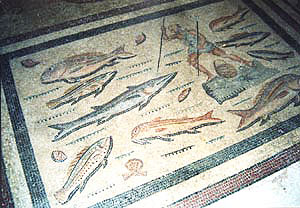
Various marine creatures fill the remainder of the picture: two dentex (1, 6),
two red mullets (5, 9), and four wrasses (2, 4, 7, 8).
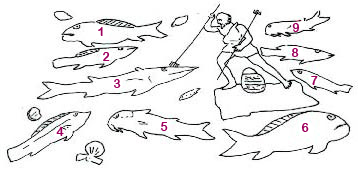
The composition exhibits the typical features of all fish mosaics in Greece: the fish are broadly spread over the surface, with no use of perspective techniques (foreshortening or overlapping). Spatial depth is implied on by dark shadow lines on their lower body contours.
The size of the fish is greatly exaggerated in relation to that of the human figure.
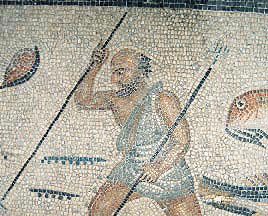
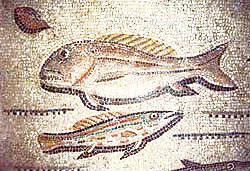
A mosaic from the island of Mytilene shows two fishermen sitting in a boat. A boy in a brown cape rows behind them.
A bearded man at the front of the boat is about to slay an octopus with his trident.
He wears a green robe with short sleeves. An upwards-pointing “knot” on the back of both figures could be a
sign that they have tied a large cloth (focale) over the undergarment (tunica) to protect them from the weather.
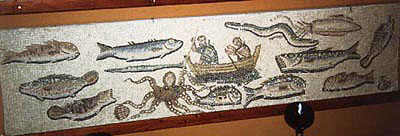

In total the mosaic artist has depicted thirteen fish and two mussels: red mullet (1),
grouper (2), painted comber (3), goldengrey mullet (4), needlefish (5), octopus (6),
sea bream (7), eel (8), sea bass (9), sea bream (10), squid (11), red mullet (12) and wrasse (13).
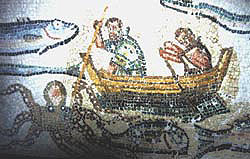
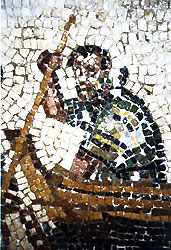
Here again the fish take up much more space than the fishermen.
Due to its open mouth, the dentex (9) even looks a little threatening to the small human figures.
The fish are clearly arranged in two parallel rows above one another.
Overlapping is visible in only two cases (octopus and sea bream; eel and squid).
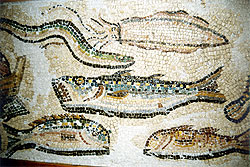
Aelian mentions the so-called kyrte as a third piece of fishing equipment.
It’s a kind of plaited fish trap which can take the form of a basket, a hat or a bottle.
According to Aelian, great strength and skill are required for this fishing technique.
For this reason he considers the use of kyrtes highly inappropriate for those members of society who have the status of free men.
What appears to be a depiction of a fisherman with a kyrte can be found in a mosaic from Melos. Today the pavement is covered and thus inaccessible. A colour drawing from the
19th century makes it clear that shortly after the excavation large parts of the
fishing scene were already missing. The boat and six sea creatures had to be added to.

In the centre of the picture is a bearded fisherman in a small boat. He wears a knoted exomis on his shoulders,
and a flat cap. The fish are arranged in a circle around the man, while their abdominal contours facie the braided frame of the mosaic picture.
Unique is the inscription above the fisherman’s head and the depiction of a bottle-like object on a long stick which the fisherman holds in the water.
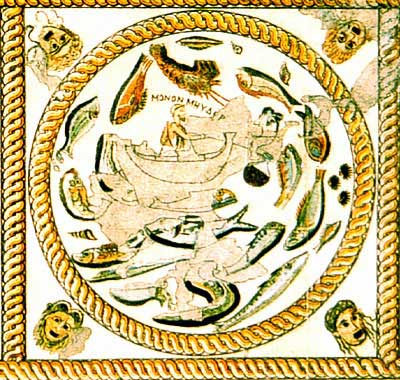
The spherical object could be a fish trap in the form of a bottle.
However at this time we can only speculate about the bottle’s material (glass?) and contents (red wine?).
In antiquity a kyrte braided from reeds or wire was common, but there is no knowledge of a similar use for glass bottles.
However there are modern examples of so-called phials and carafes which prove that class containers can be used for fishing. A piece of bread or manure is put in the bottle as bait. The base contains a round opening through which small fish
like gudgeon or salema porgy (a species of sea bream) can swim. These fish are then caught in the bottle and removed through the upper, previously sealed opening.
It’s possible that the round object in the mosaic from Melos represents such a fishing bottle.
This assumption is strengthened by depictions of kyrtes in the form of bottles in North African mosaics.
Accordingly, the picture could be interpreted as a genre scene and the inscription translated as "just don’t catch water".
The last method of fishing Aelian mentions is by means of a rod and line. In his opinion this is the best method for free men.
A small panel with a fishing scene comes to us from Thessaloniki. A young man sits alone on a rock at the shore. In his right hand one recognises part of a fishing rod. He is typically attired for his profession: an exomis and a wide-brimmed straw hat.
In front of him in the water are two different types of fish (perhaps gilthead sea bream and grouper).

Parallels to this depiction can be found in large numbers in North Africa,
although there the fishermen are usually part of a larger composition with multiple figures.
In the port district of Kos another mosaic was excavated showing a fisherman facing forward. He is a chubby-faced youth with short dark hair, wearing a tunic with a belt and a hat that
rises to a peak (pileus). In his left hand he holds a small basket and in the right a fishing rod on which a fish is already hooked.
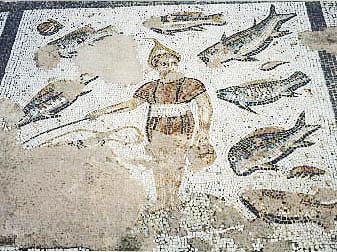
Fourteen sea creatures are positioned in a crescent shape around him: red mullet (1), mussels (2,5,7,10), grouper (4), wrasse (6,8,11,14), see bass or grey mullet (9), gilthead sea bream (12)
and a species of slipper lobster, scyllarus arctus (13). As with the other fish mosaics dealt with here, primarily edible fish are depicted.
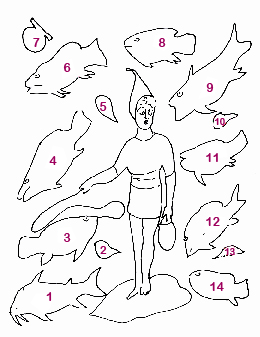
In the course of our study it was notable that the sea creatures are disproportionately large compared to the human figures.
Presumably the Roman artists are reverting to the method of showing comparative significance. The fish that were depicted were regarded as xenia (gifts that express wealth and culinary luxury). For ancient observers they would have therefore been more important and more interesting than the fishermen themselves.
In addition, as many different fish species as possible were supposed to be combined in one mosaic, so that the compositions reflect the wealth and variety of marine life. The mosaic artists could only show differences in scales and fins if they worked with a predetermined minimum size for the fish.
The relatively crudely cut stone cubes used in Roman times (edge length of 0.5-1.5cm) wouldn’t have allowed for a smaller or more sophisticated depiction.
In the mosaics that have been discovered in Greece up to now, the role of the human figures is emphasised by their central position in the picture.
The sight of fishermen in action presumably provoked various associations and thoughts in the ancient observer.
The figures of fishermen embody the world of the simple rural dweller who lives in direct contact with nature. In some pictures the decisive moment of catching the fish is represented, but not in a way that implies great drama or brutal intervention in the sphere of marine life. Men and sea creatures aren’t opposite poles bound by enmity. Rather they are harmoniously connected.
The scenes thus attain a certain idyllic character – very much in the tradition of the idealised bucolic images of the Hellenistic period.
The artistic medium also allows the fishing methods described in the literature of the time to be presented clearly. The person contemplating the fishing pictures immediately understands which skills are required by the different techniques,
namely manly strength and skill in thrusting with a harpoon (fig. 2. 9), or calm and patience in the case of rod fishing (fig. 13. 14).
Perhaps the mosaics are also meant to allude to the fact that the owner of the house rules over a large number of subordinates,
among whom the fishermen are of course counted. Thus the supply of fresh fish for him and his guests is guaranteed.
In Roman art fishermen of all age groups appear. In our examples only the fisherman in the mosaic from Kos, with his bald head and sharp facial features, is clearly characterised as an older man (Fig. 4). In Mytilene and Melos the fishermen often have a full beard and appear to be middle-aged (fig. 9).
In contrast, the men with rods in the mosaics in Thessaloniki and Kos seem to be very young (fig. 13. 14).
The age of the fishermen doesn’t bear any relation to the fishing method being depicted, in contrast to some examples which come from outside Greece.
The mosaics with fishing scenes found in Greece are relatively small. None of them are bigger than four square metres. The compositions lack the variety and originality of their North African counterparts. The scenes are easy to take in. As our investigation has shown, as a rule only one fisherman is depicted (the exception being in Mytilene) surrounded by diverse sea creatures. However, this shouldn’t lead to the conclusion that Greek mosaic artists were of limited ability.
It’s more likely that the main reason was the preference in Greece for smaller panels.
Most places in which fish and fishing mosaics were found are situated near the sea and so have a close association with the act of fishing (Kos, Mytilene, Melos and Thessaloniki). The pavements decorated either dining rooms or porticos.
The size and layout of such buildings suggests that they were primarily for private use. There was no evidence of a fishing guild.
R.D. De Puma, The Roman Fish Mosaic (Ph.D. Microfilm, Bryn Mawr College
1969).
C. Belz, Marine Genre Mosaic Pavements of Roman North Africa (Ph.D. Microfilm,
University of California Los Angeles 1978).
P.G.P. Meyboom, I mosaici pompeiani con figure di pesci, MededRom 39,
1977, 49ff.
G. Gullini, I Mosaici di Palestrina (1956) Taf. 2. 6-12.
Pompei, Pitture e Mosaici V. Istituto della Enciclopedia Italiana. Fondata
da Giovanni Treccani (1994) 107 Abb. 30 (Pompeji, Casa del Fauno).
L. Foucher, Inventaire des mosaïques, feuille no. 57 de l'Atlas archéologique:
Sousse (1960).
L. Schneider, Die Domäne als Weltbild (1983) 58.
A. Kankeleit, Fisch und Fischer, in: AntikeWelt 2003/3, 273-278.
A. Kankeleit, Représentations de pêcheurs sur des mosaïques
en Grèce, in: Akten des 7. Internationalen Mosaikkongresses in
Tunis, 3.-8.10.1994 (2000) 69-79.
Argos: P. Assimakopoulou-Atzaka, Syntagma ton palaiochristianikon psephidoton
dapedon tes Ellados II (1987) 53ff. Taf. 35,1.
Mytilene: I. Tsirivakos, ADelt 30,2, 1975, Chron 314 Taf. 218.219.
Platon, Sophistes 220f.
Aelian, Natura Animalium 12,43
Oppian, Halieutica 3,341ff.
C. Plinius Secundus d.Ä., Naturkunde, Lateinisch-Deutsch. Buch IX.
Zoologie: Wassertiere (1979); Buch XXXII, Medizin und Pharmakologie: Heilmittel
aus dem Wasser. Herausgegeben und übersetzt von R. König u.a.
(1995) Register s.v. Fisch.
H.P. Laubscher, Fischer und Landleute (1982).
E. Bayer, Fischerbilder in der hellenistischen Plastik (1983).
N. Himmelmann, Über Hirten-Genre in der antiken Kunst (1980) 88f.
E. Pochmarski, Gymnasium 92, 1985, 259.
Reallexikon für Antike und Christentum VII (1969) 987f. s.v. Fisch
(J. Engemann).
O. Keller, Die Antike Tierwelt II. Vögel, Reptilien, Fische, Insekten
u.a. (1913) 328ff.
D. Bohlen, Die Bedeutung der Fischerei für die antike Wirtschaft
(1937).
Das Kochbuch der Römer. Rezepte aus der "Kochkunst" des Apicius.
Eingeleitet, übersetzt und erläutert von E. Alföldi-Rosenbaum
(1970) 93ff.
Das römische Kochbuch des Apicius. Vollständige zweisprachige
Ausgabe. Herausgegeben, übersetzt und kommentiert von R. Maier (1991)
146ff.
Kochen wie die alten Römer. 200 Rezepte nach Apicius für die
heutige Küche umgesetzt von H.-P. von Peschke und W. Feldmann (1995)
49ff.
Abb. 1. 2. 3. 4. 5. 6. 7. 8. 9. 10. 13. 15 (Verf.);
Abb. 11. 12 (Bosanquet, JHS 18, 1898); Abb. 14 (Norbert Franken)
Sincere thanks to Dr. Klaus Busse (Zoologisches Forschungsinstitut and Museum A. Koenig in Bonn)
who was a great help in analysing the representations of fish.
For their invaluable support I’m also indebted to A. Archontidou-Argyri,
L. De Matteis, A. Dreliossi, D. Grammenos, Ph. Pachyjanni-Kaloudi, E. Waywell,
Ch. Williams and I. Vokotopoulou.